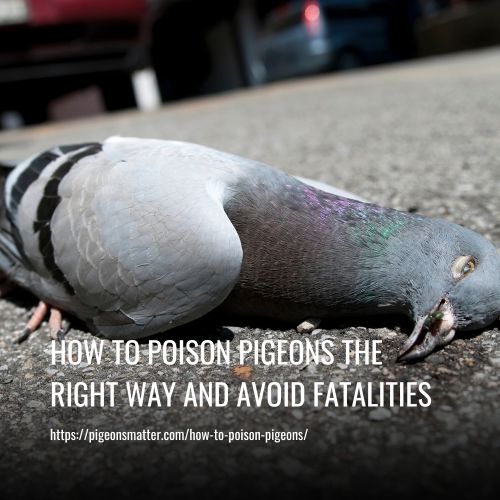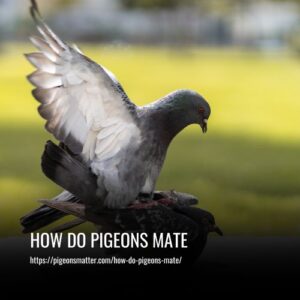Poisoning pigeons is a common way to rid your property of these pests. There are many ways to poison pigeons, but all require careful instruction and execution. The most common methods are using grain or pellets laced with poison, shooting them with a pellet gun, or feeding them chocolate or sugar that has been laced with poison. Each method has its risks and benefits.

Is it legal to poison birds in the USA?
The legal status of poisoning birds in the USA varies depending on the species. Protected by the Federal Migratory Bird Treaty Act, most bird species are off-limits for lethal control measures. But, pigeons, English house sparrows, and European starlings, often regarded as nuisance birds, are not protected. This means that pigeon poisoning is legal as long as it does not conflict with animal welfare ordinances in your community.
However, it’s vital to note that State regulations may prohibit poisoning of any kind and may carry penalties. The USA is one of few first-world markets where poisoning birds remain sanctioned. While the country permits the use of avicides, most of the world banned the practice decades ago.
If you plan to use poison for pigeon control, it’s essential to seek advice from local and state regulatory agencies as regulations may vary from one region to another. Further, the use of restricted poisons like 4-aminopyrimidine or Avitrol requires training and certification. You must never risk the lives of non-target species or bystanders. Therefore, pesticide application should be done by experienced technicians who know how to minimize the risks associated with bird poison.
What are the pigeon poisons available in the USA?
Avitrol (4-aminopyrimidine) is the only remaining registered pigeon poison commercially available in the USA. This bird toxicant is used as a frightening agent in starlings, blackbirds, sparrows, crows, and house sparrows, along with pigeons. The active ingredient, 4-aminopyridine, is an acute oral toxicant, which affects the central and motor nervous system. The product is registered as a restricted-use pesticide by EPA; hence only pest control applicators with a restricted-use pesticide license can use it.
Avitrol can be toxic to all vertebrate species, not simply birds. It causes behaviors that are typical of an epileptic seizure or convulsion. Birds eating treated bait go through a slowed and nonviolent death process. It causes distress and alarm cries and visual displays used by their species when frightened or injured. This can include flying erratically, vocalizing, trembling, dilation of the pupils, and other symptoms that lead to a loss of motor control.
An alternative to Avitrol is the avicide called DRC-1339, developed by the US Department of Agriculture (USDA). It is a lethal dose and meant to poison birds, unlike Avitrol, which is used to frighten them. Birds die a slow, nonviolent death by uremic poisoning and organ congestion. Pest control companies typically use this product only in agricultural areas because of the risk of extensive bird kills in urban areas, but it can be used in the city as well.
What is the history of bird poisons?
In ancient civilizations, people have been using poisons to control pests, including birds, for hundreds of years. Arsenic and Strychnine were known to be toxic to a broad range of species, including birds. However, it wasn’t until the 1940s that synthetic pesticides, like DDT, were widely used as insecticides.
While DDT was effective, it accumulated in the food chain and ended up in relatively high levels in apex predators, such as the Peregrine falcon and Bald eagle. The DDT residues caused these bird species to nearly become extinct as their eggshells became thin and cracked.
Unfortunately, a variety of bird species were also unintended victims of avicides, including Strychnine and Fenthion, introduced as avicides in the 1950s and 1960s. Most of these products have been banned by the EPA for non-target hazards with one exception, Avitrol, which uses 4-aminopyrimidine as its active ingredient.
While bird poisons can be quite effective, it is important to remember the impact on bird populations. Most avicides have been banned due to their impact on non-target species, making it crucial to choose an avicide carefully. Today, non-lethal measures, such as bird netting, bird spikes, or bait stations, are often preferred options for controlling bird populations.
Are there other pigeon poisons available around the world?
Apart from the avicides previously mentioned, there are other pigeon poisons registered in various markets across the globe. One of the most notable examples is alphachloralose, a stupefying agent that is effective in both birds and rodents. At lower doses, it places the target species in a state of drowsiness, whereas at higher doses, the effect is irreversible.
However, several regulatory bodies prohibit the use of certain pigeon poisons due to their non-target hazards. For instance, thallium was a common pigeon poison before less toxic substances were invented. Yet, it poses severe risks to other animal species and humans. Additionally, some people use antifreeze to poison birds, an illegal method associated with enormous non-target risks.
How effective is poisoning pigeons?
When considering pigeon control methods, one may believe that poisoning pigeons is an exceptionally effective technique. However, in reality, it only provides an illusion of effective control, since other birds can quickly move in or the remaining flock can rapidly repopulate due to increased breeding. As a result, it is a short-term strategy that yields little long-term effect.
For example, suppose a site had initially 100 pigeons, and 50 were poisoned. In that case, within just a few weeks, the pigeon population will return to the same number. Therefore, poisoning pigeons becomes a chronic cycle of killing birds with little long-term impact, which makes it a less effective option compared to other methods.
To increase the effectiveness of pigeon population control, poisoning could be used in combination with other approaches, such as birth control, bird netting, bird spikes or bird wire. Successful pigeon culling can be achieved through poisoning, but it is only effective when used in conjunction with other practical strategies.
Moreover, it is essential to consider the potential risks of pigeon poisoning, such as non-target hazards, harm to other animal species and humans, and the possibility of infecting pigeons with fungal or infectious diseases. Pest controllers should ensure the use of protective equipment and implement humane measures, such as non-lethal methods, to reduce involuntary muscle movements and minimize harm to the birds.
Using poison to kill pigeons – good or bad idea?
Using poison to kill pigeons may seem like a quick and easy solution, but it is a risky method that can lead to potential harm. While pigeons can be pests, they are still living creatures with a unique place in our society. As such, it is essential to consider humane ways of reducing their population.
By using poison to kill pigeons, you run the risk of killing non-target animals, including protected species, which can result in hefty fines. Accidental ingestion by pets or wildlife can also occur, leading to unintended harm.
Moreover, poison only offers a temporary solution because it indiscriminately reduces the population, and new pigeons can quickly replace the ones that were eliminated. Additionally, disposing of dead birds can be problematic, and the public reaction to the use of poison is often negative.
How does pigeon poison work?
Bird poisoning is a serious issue and the use of poison to control populations of certain species requires careful consideration. Pigeon poison, also known as avicide, is a potent chemical that comes in pellet or grain form and is typically administered in areas frequented by flocks of pigeons. Often, avicides are mixed with normal food to entice pigeons into feeding without suspicion, and due to the birds’ scavenger nature, they can digest almost anything.
Once ingested, avicides attack the nervous systems of pigeons, impairing their natural faculties and leading to disorientation, erratic flight control and violent convulsions. These symptoms inevitably lead to fatal outcomes, with the birds unable to recover from the effects of the poison.
While pigeon poison can be an effective solution, it has significant drawbacks. For one, it poses a significant danger to non-target animals, including protected species, and can result in steep penalties for parties caught using it improperly. Additionally, avicides offer only a temporary solution, as pigeons will rapidly repopulate areas where their numbers have been reduced.
Pros of using poison to kill pigeons
Using pigeon poison can be an effective solution for reducing pigeon populations due to its low cost and high success rates. This method provides accurate targeting and quick action, resulting in reducing the population and controlling the damage caused by pigeons.
However, it is important to note that this method of pigeon control should only be used as a last resort. The disadvantages and threats posed to surrounding wildlife and pets outweigh these benefits. We recommend seeking alternative methods that prioritize humane measures and disease control while reducing property damage caused by pigeons.
Cons of using poison to kill pigeons
When it comes to controlling the pigeon population, it’s important to weigh all options in order to make an informed decision. Although poisoning pigeons may seem like a quick and effective solution, the potential risks and repercussions simply cannot be ignored.
Firstly, it’s important to note that poisoning pigeons with avicides results in a lethal outcome for the bird, just like any other poison. While this may seem like a viable option, once the bird has ingested the poison it may not necessarily die in a noticeable place. This can result in an unpleasant odor and make it difficult to dispose of the body. Furthermore, a flock of pigeons will likely be affected by the poison, which can result in a large number of carcasses that need to be dealt with.
Another point worth considering is that pigeons often carry diseases and parasites which can be hazardous for humans to come in contact with. This makes disposing of the bodies a potentially risky process that pest control experts need to approach with caution.
The risks of poisoning pigeons extend beyond just the birds themselves. Since it is often difficult to control which animals consume the bait, there is a danger that non-targeted wildlife may also be affected. Moreover, if the poisoned pigeons are consumed by other animals in the food chain, it can result in secondary poisoning, creating a ripple effect.
Given these risks, it is important to explore alternative, more humane methods of pigeon control. Pest controllers may use methods such as bird netting, spikes, or wire to deter the birds from roosting in certain areas. Additionally, by providing the birds with birth control, it is possible to reduce pigeon population growth without causing harm to the birds.
What are the main ingredients?
Pigeon poisons are commonly used to control pigeon populations, but it is critical to understand the main ingredients that make up these poisons.
Alphachloralose: A common avicide component, alphachloralose comes in treated grain form which is disguised by being mixed in with the pigeons’ regular feed. This allows the pigeons to get accustomed to the taste and texture before switching to the poison. The active ingredient makes the pigeon feel like they are in a stupor-state which ultimately leads them to death.
Avitrol: This poison contains 4-aminopyridine, which attacks the pigeon’s central nervous system. It causes convulsions that affect their flying ability, causing them to fall and flap before plummeting to their death.
Thallium: This highly toxic metal is a popular poison for pigeons. It can be administered through inhalation or oral consumption. This tasteless poison can be mixed with food or dissolved in water. Thallium is known for inducing nausea, vomiting, and pain before ultimately leading to death.
What foods are poisonous to pigeons?
Pigeons are omnivorous and opportunistic feeders, meaning they can eat a variety of foods. However, there are some foods that are poisonous to pigeons and should be avoided.
Foods Poisonous to Pigeons
Pigeons are known for their scavenger-like behavior and it is not unusual to spot them perched atop bins or dumpsters, digging for food. However, some store cupboard items that can be found in your kitchen are highly toxic to them and may result in fatal consequences.
Toxic Foods
Chocolate, caffeine, alcohol, avocado, onions, garlic, tomato leaves and fruit seeds contain toxins that can be harmful to pigeons when ingested in large enough quantities. These foods can cause a range of symptoms from vomiting, diarrhea, and abdominal pain to heart failure and even death.
Potential Harm
It is important to recognize the potential harm that can come from offering these foods to pigeons as it can not only result in the unnecessary death of birds but it can also be a public health concern.
Prevention
The most effective way to prevent pigeons from consuming these poisonous foods is to properly dispose of waste and ensure that it is not readily accessible to birds. You should always be mindful when disposing of foods that could be harmful to birds, especially if you live in an area with a high population of pigeons.
What are the Other Methods to Cull Pigeons?
The two other common methods for culling pigeons are live trapping and shooting. Unfortunately, both of these methods suffer from similar limitations to poisoning. Typically, live trapping or shooting only removes a percentage of the population, leaving the rest to breed and rapidly replenish their numbers within a matter of weeks or months.
As a result, increasing the mortality rate of the flock – regardless of whether it is done through traps, guns, or poison – can only be viewed as more of a harvest than an effective control program. Ultimately, whatever remains after culling represents the core of a new population that will quickly expand to fill the void, especially given how rapidly pigeons can breed.
Is Shooting Pigeons an Acceptable Method of Control?
Shooting pigeons as a control method may have its limitations. While it may be considered acceptable, there are a variety of legal considerations to keep in mind. Shooting birds in urban areas, for instance, is prohibited and can lead to unintended consequences. Even on private property, shooting is not recommended as it can be harmful. OSHA-inspected facilities also commonly prohibit firearms in the workplace, making shooting an undesirable method in some scenarios.
As a result, shooting as a method of pigeon control may only be practical in remote or rural locations. In other cases, alternative options such as trapping or birth control measures may be more effective. Although shooting can reduce pigeon populations, it is important to have an informed understanding of the risks and limitations associated with this approach. Ultimately, careful consideration of all factors must be taken before making a decision on the use of an air rifle or other shooting methods.
How Are Traps Used for Pigeons?
When it comes to pigeon control, live traps are commonly used to safely capture these birds. There are several types of traps available, including cage and net traps, although they all share the same basic configuration.
During a conditioning period, the trap is baited with grains and the pigeons can freely enter and exit the trap through a door. Once the birds are acclimated and comfortable with the trap, the door can be switched to one-way, trapping the birds inside.
However, it is important to note that trapped pigeons must be humanely euthanized, as they cannot be relocated. This is due to pigeons’ strong homing ability, which means they are likely to return to their original location if they are released elsewhere.
FAQs
As per the integrated pest management philosophy, trapping can be complemented by non-lethal techniques for effective pigeon control. Combining trapping with birth control can help manage the pigeon population by reducing their reproduction rate and increasing mortality. This approach offers the best possible outcome by utilizing both lethal and non-lethal methods.
One effective and natural method for controlling pigeon populations is through the use of raptors or birds of prey. As pigeons are a natural prey species, a variety of hawks, owls, and falcons will naturally prey on them. The Peregrine falcon, in particular, is capable of taking down a flying pigeon.
However, relying on naturally occurring raptors is not always feasible. To attract and utilize raptors as a means of pigeon control, installing nesting habitats such as an owl box is a viable option. Building plans for these boxes can typically be obtained through the State Coop Extension Service.
There are no foods that we can use to poison pigeons. In fact, feeding uncooked rice, salt, Alka-Seltzer, spices, or other substances to pigeons will not harm them and is simply an urban legend. It is also important to note that if a substance is toxic to mammals, it is likely to be even more toxic to birds. Therefore, it is best to avoid attempting to poison pigeons with food.
Conclusion:
The act of intentionally poisoning pigeons is an illegal and unethical method of controlling their population. It not only harms birds but also pose public health risks and can potentially harm other species of birds, including birds of prey.
Instead of resorting to such cruel and harmful practices, it is recommended to explore humane and non-lethal methods of pigeon control, such as bird netting, bird spikes or bird wire. These solutions can prevent pigeons from accessing comfortable nesting spots and food sources without causing harm to the birds themselves.


